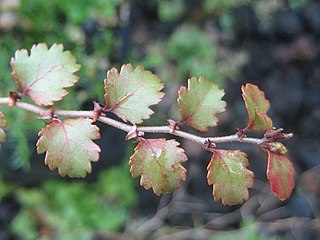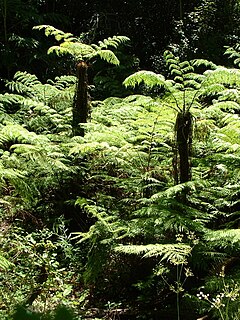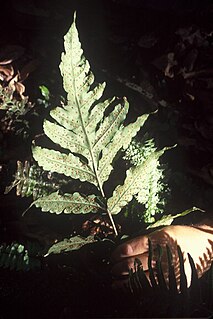
The tree ferns are arborescent (tree-like) ferns that grow with a trunk elevating the fronds above ground level, making them trees. Most tree ferns are members of the "core tree ferns", belonging to the families Cyatheaceae, Dicksoniaceae, Metaxyaceae, and Cibotiaceae in the order Cyatheales. It is estimated that Cyatheales originated in the early Jurassic, and is the third group of ferns known to have given rise to tree-like forms. The others are the extinct Tempskya of uncertain position, and Osmundales where the extinct Guaireaceae and some members of Osmundaceae also grew into trees. In addition there was the Psaroniaceae and Tietea in the Marattiales, which is the sister group to true ferns.

The Antarctic flora is a distinct community of vascular plants which evolved millions of years ago on the supercontinent of Gondwana. It is now found on several separate areas of the Southern Hemisphere, including southern South America, southernmost Africa, New Zealand, Australia and New Caledonia. Joseph Dalton Hooker was the first to notice similarities in the flora and speculated that Antarctica had served as either a source or a transitional point, and that land masses now separated might formerly have been adjacent.

Alsophila capensis, synonym Cyathea capensis, is a regionally widespread and highly variable species of tree fern. It is indigenous to Southern Africa and South America.
Tectaria chimborazensis is a species of fern in the family Tectariaceae. It is endemic to Ecuador.

Tectaria is a genus of fern in the family Tectariaceae, according to the Pteridophyte Phylogeny Group classification of 2016. Halberd fern is a common name for species in this genus.
Tectaria morlae is a species of fern in the family Tectariaceae. It is endemic to Ecuador. Its natural habitat is subtropical or tropical moist lowland forests. It is threatened by habitat loss.
Tectaria quitensis is a species of fern in the family Tectariaceae. It is endemic to Ecuador. Its natural habitat is subtropical or tropical moist lowland forests. It is threatened by habitat loss.
Tectaria subrepanda is a species of fern in the family Tectariaceae. It is endemic to Ecuador. Its natural habitat is subtropical or tropical moist lowland forests. It is threatened by habitat loss.
Tectaria triloba is a species of fern in the family Tectariaceae. It is endemic to Ecuador. Its natural habitats are subtropical or tropical moist lowland forests and subtropical or tropical moist montane forests. It is threatened by habitat loss.

Microgramma is a genus of ferns in the family Polypodiaceae, subfamily Polypodioideae, according to the Pteridophyte Phylogeny Group classification of 2016 (PPG I). They are commonly known as vine ferns or snakeferns.

Rumohra adiantiformis, the leather fern or leatherleaf fern, is a species of fern in the wood fern family Dryopteridaceae. It has a wide distribution, mainly in the tropical Southern Hemisphere.

Nuxia floribunda, the forest elder, forest nuxia or wild elder, is a species of tree in the Stilbaceae family, that is native to moist regions of southern Africa, East Africa and central tropical Africa.

Tectaria estremerana is a rare species of fern known by the common name Puerto Rico halberd fern. It is endemic to Puerto Rico. It is a federally listed endangered species of the United States.

The Ficus sansibarica, known as knobbly fig, is an African species of cauliflorous fig. It is named after Zanzibar, where Franz Stuhlmann discovered it in 1889. They often begin life as epiphytes, which assume a strangling habit as they develop. They regularly reach 10 m, but may grow up to 40 m tall as forest stranglers.

Dryopteris inaequalis is an Afrotropical fern species that ranges from tropical and southern Africa to Madagascar. It has been recorded in Tanzania, Zambia, Malawi, Mozambique, Zimbabwe and South Africa, where it is present in the Western Cape, Eastern Cape and KwaZulu-Natal. It is found on forest floors and along forest margins, from middle to high altitudes.

Adiantum philippense,, also known as walking maidenhair fern, or black maidenhair, is a species of maidenhair fern (Adiantum) that is widely distributed through the southern hemisphere, notably Asia, Africa, and Madagascar.

Chrysophyllum viridifolium, commonly known as fluted milkwood, is a potentially large species of evergreen milkwood tree that occurs in East African coastal forests, southerly coastal forest mosaics and in some inland forests of the tropics and subtropics.

Microcoelia exilis, commonly known as the pinhead orchid, is a species of flowering plant in the orchid family, Orchidaceae. It is a leafless epiphyte, a perennial herb that grows in a tangled cluster of roots and stems on the branch of a tree. This orchid is native to tropical central and eastern Africa and was first described in 1830 by the English botanist John Lindley.
Vachellia kirkii, widely known as Acacia kirkii but now attributed to the genus Vachellia, is a tree native to tropical Africa. It is commonly known as the flood plain acacia.













